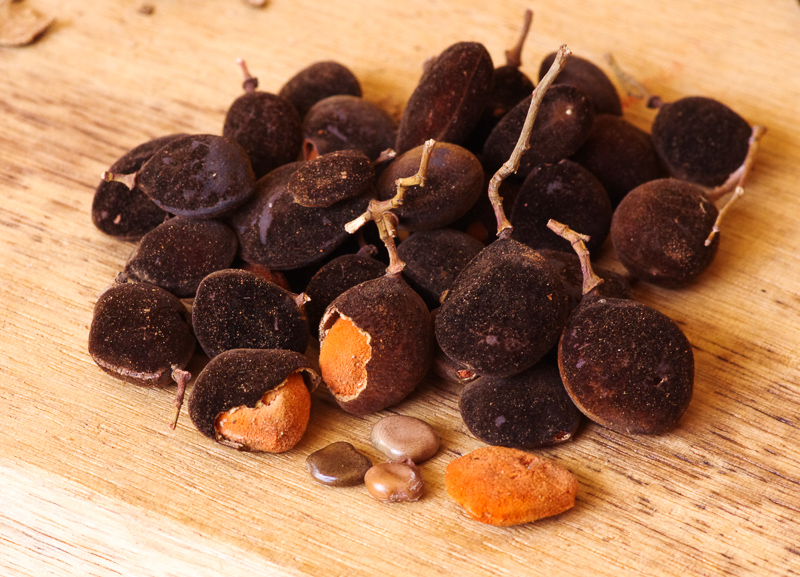Dialium guineense

|
|
Dialium guineense Common Names: Velvet Tamarind, Black Tamarind, Tumble
Tree, African Black Velvet Scientific
Classification Kingdom: Plantae Clade: Tracheophytes Clade: Angiosperms Clade: Eudicots Clade: Rosids Order: Fabales Family: Fabaceae Subfamily: Caesalpinioideae Genus: Dialium Species: D. guineense Binomial Name: Dialium guineense Willd. Synonyms: Morphological Description Dialium guineense is a deciduous tree, typically 10–25 m tall, occasionally
reaching 30 m, with a trunk diameter of 60–80 cm. Key features include: · Stem: Straight, greyish, smooth bark, slash reddish, exuding red
gum · Leaves: Pinnate, 15–25 cm long, with 5–7 alternate leaflets, each
5–10 cm long, 2–4 cm wide, dark green, glossy · Flowers: Small, greenish-white, 5–10 mm across, in dense panicles,
blooming September–October · Fruit: Drupe, 2–2.5 cm diameter, dark brown to black, brittle
shell, sour-sweet brown pulp, 1–2 seeds, fruiting October–January Distribution and Habitat Dialium guineense is native to West and Central Africa, thriving in: · Regions: Rainforests, secondary forests, savanna-forest transition
zones · Countries: Senegal, Guinea-Bissau, Sierra Leone, Ghana, Togo, Benin,
Nigeria, Cameroon, Central African Republic · Climate: Tropical, 25–35°C, rainfall 1,200–2,500 mm annually · Soil: Well-drained, loamy to sandy, pH 5.0–6.5 · Elevation: Sea level to 1,000 m Ethnopharmacology Dialium guineense, commonly known as
velvet tamarind, is a tropical plant native to West Africa, widely used in
traditional medicine for its rich nutritional and therapeutic properties. The
fruit, bark, leaves, and roots of the plant have been shown to possess
antioxidant, antimicrobial, anti-inflammatory, antidiabetic, and antimalarial
properties. It is traditionally used to treat coughs, diarrhea, malaria,
wounds, ulcers, and dysentery, and also serves as a remedy for toothache and
sore throat. The fruit pulp is rich in vitamin C, iron, calcium, and
polyphenols, which contribute to its immune-boosting and anti-aging effects.
Studies have highlighted its potential to lower blood glucose, protect the
liver, and act as a natural antibiotic. Despite its wide use in ethnomedicine,
most therapeutic claims are based on traditional knowledge and early-stage
research, so clinical validation is still necessary to confirm its efficacy and
safety in humans. · Digestive Issues: Fruit pulp is used to treats diarrhea;
pulp extracts reduce diarrhea in rats (70% at 200 mg/kg) (Assiki et al., 2022). · Anti-malarial: Leaf extracts are used to combat malaria; show
anti-plasmodial activity (IC₅₀ 12 µg/mL) (Odugbemi et al., 2007). · Anti-inflammatory: Bark are used to reduces swelling;
dichloromethane fraction inhibits edema in rats (56% at 50 mg/kg) (Okeke et
al., 2016). · Pain Relief: Stem bark are used to eases headache; methanol extract
reduces writhing in mice (60% at 500 mg/kg) (Ezeja et al., 2011). · Antimicrobial: Leaf extracts are used to fight infections; inhibit Staphylococcus aureus (MIC 0.63 mg/mL) (Olajubu et al., 2012). · Antioxidant: Antioxidant study showed significant
(p<0.05) increases in the superoxide dismutase, catalase activities and
glutathione concentrations of the co-treated groups compared to the untreated
group (Johnlouis, et al., 2024).. · Anti-ulcer: for the gastro-protective estimation, ulcer
index and percentage protection score of the treatment groups were significantly
(p<0.05) lower than those of the untreated groups and the standard drug
(omeprazole) in a dose-dependent manner. There were significant (p<0.05)
elevations in red blood cell and hemoglobin concentrations respectively in the
groups co-treated with different fractions of Dialium guineense. The result
also indicated a significant (p<0.05) decrease in the tumor necrotic
factor-α and the interleukin-1β concentration across the fractions group
compared with the normal group. The organ histology showed protected stomach architecture in the
co-treated groups compared to that of the negative control which showed full
laceration of the stomach wall (Johnlouis, et al., 2024. · Oral Care: Pulp is used to aids dental health; high vitamin C content
(23 mg/100 g) supports gums (Akinpelu et al., 2011). ⚠ Toxicity Profile: No acute toxicity at traditional doses,
Excessive fruit pulp may cause mild GI irritation due to acidity. Additional Uses · Culinary: Pulp eaten raw, juiced, or added to stews and cakes · Timber: Hard, durable wood for construction, tools, fuel · Economic: Fruit traded locally; annual Senegal yield >100 tons · Ecological: Provides shade, supports biodiversity; Vulnerable References
External Links More Pictures |
|
| Compounds of Dialium guineense | |
| References | Essien E, Ogunwande IA, Ogunbinu AO, Flamini G, Cioni PL. (2007) Extraction and identification by GC-MS the volatile constituents of Dialium guineense Willd. Journal of Essential Oil Research |